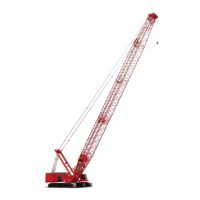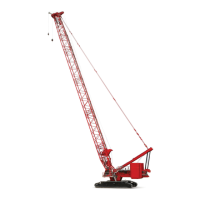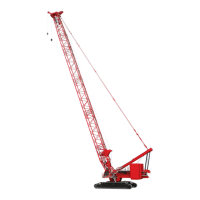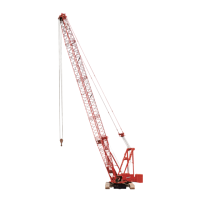Manitowoc Published 11-22-17, Control # 257-02 3-17
MLC300 SERVICE/MAINTENANCE MANUAL ELECTRICAL SYSTEM
Limit Switches—Dual Contact
In the non-tripped state, a controller provides power to the
normally closed contact and grounds the normally open
contact. A controller digital input reads the applied power
through the normally closed contact back through the
common center terminal as a logic high. When the switch is
tripped, the normally closed contact opens, breaking the
current path through the common terminal. At the same time,
the normally open contact closes, grounding the common
terminal and sending a controller digital input a logic low
signal.
Dual contact limit switches are used to sense the travel limits
of the following crane functions:
• Drums 1, 2, 3, and 6 minimum bail limit
• Drums 4 and 6 pawl limit
• Maximum boom angle limit
• Mast position limit
• Swing limit
Limit Switches—Single Contact
In the non-tripped state, a controller provides power to the
normally closed contact. A controller digital input reads the
applied power back through the normally closed contact as a
logic high. When the switch is tripped, the normally closed
contact opens, breaking the current path through the
common terminal. The controller digital input reads this as a
logic low.
Single contact limit switches are used for the following crane
functions:
• Lower boom point block-up limit
• Lower boom point block-up slow down
• Upper boom point block-up limit
• Upper boom point block-up slow down
• Luffing jib minimum angle
• Luffing jib maximum angle
• Fixed jib block-up slow down
• Fixed jib block-up limit
Solenoids
Solenoids are driven by controller digital outputs and activate
hydraulic valves and provide control of the following
cylinders, valves, and pumps:
Angle Sensors
A controller provides power to the angle sensor. The sensor
outputs an analog signal that is proportional to the sensor
angle. A controller analog input reads this output voltage,
and the controller software determines the mast angle based
upon the signal level. The angle sensors are used to
measure the following items:
• Live mast angle
• Jib butt angle
• Boom angle
• Boom top angle
• Rotating bed pitch and roll
Alarms
A controller digital output drives the applicable alarm during
various operational states:
• Swing motion
• Travel motion
• Load approaching or exceeding capacity
Load Pin Sensors
A controller digital output provides power to the load pin
sensors. A strain gauge within the load pin produces an
analog output current that is proportional to the load. A
controller analog input reads this output current, and the
controller software determines the value of the load based
upon the current level. The load pin sensors monitor the
following loads:
• Mast strap
• Right and left strap links
• Upper boom point light fixed jib
Brake release cylinders Diverter valves
Drum pawl cylinders Jack cylinders
Mast cylinders Pin pusher/puller cylinders
Cab tilt cylinders Cooler fan pump
Self-assembly cylinder Left and right system valves
Cylinder stowage Crawler tensioner cylinders
Rigging winch (drum 0)

